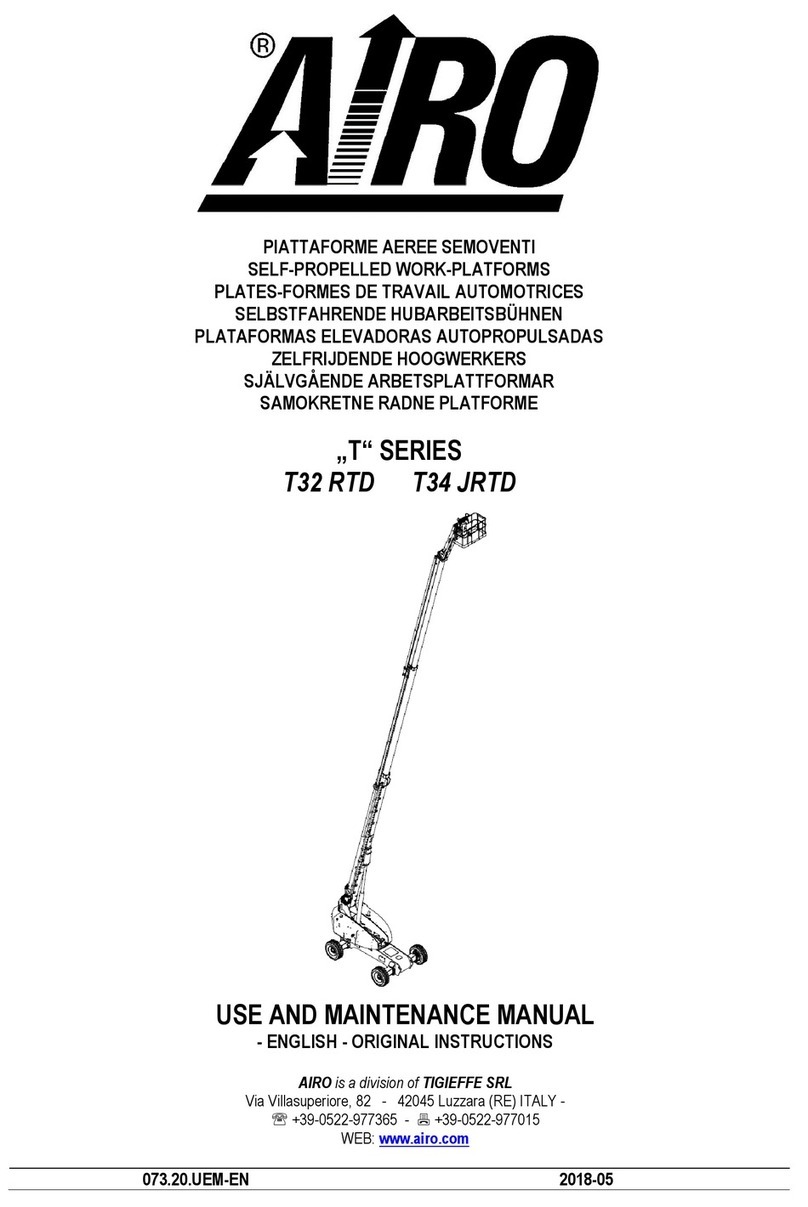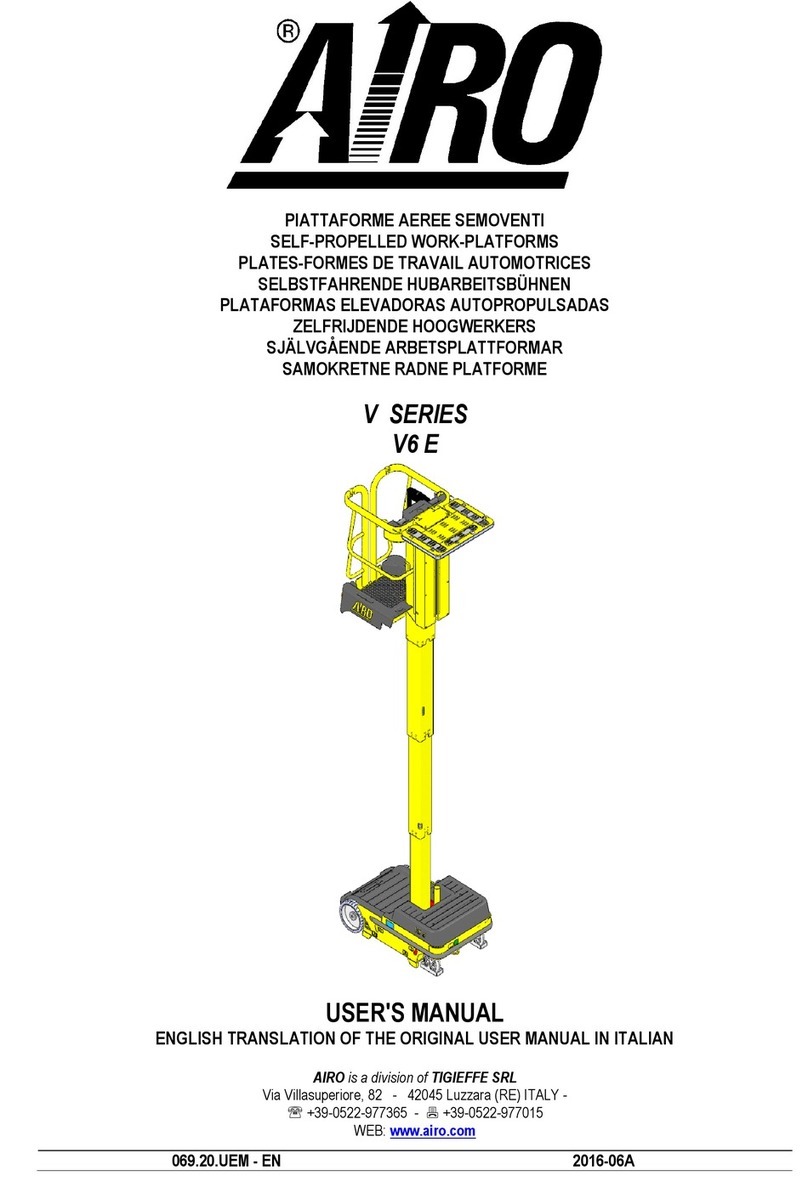
User’s Manual – A16 J A18 J Series
5.1.2.6. Basket rotation .......................................................................................................................................... 42
5.1.2.7. Basket levelling ......................................................................................................................................... 42
5.1.3. Other functions of the control panel on the basket.................................................................................... 43
5.1.3.1. Selection of the (OPTIONAL) electric or gasoline/diesel power ................................................................ 43
5.1.3.2. OPTIONAL electric pump starter 12V (Battery) or 230V/ 380V (in-house power)..................................... 43
5.1.3.3. Engine Starter Button (models “D” and “ED”)............................................................................................ 43
5.1.3.4. Manual horn .............................................................................................................................................. 43
5.1.3.5. Emergency stop button ............................................................................................................................. 43
5.1.3.6. Warning lights............................................................................................................................................ 44
5.1.3.6.1 Green pilot lamp (ZA), operator's station enabled..................................................................................... 44
5.1.3.6.2 Red pilot lamp (ZB): warns when the battery is out of charge. (only available on electrical models) ........ 44
5.1.3.6.3 Red pilot light (ZC): diesel engine fault or low fuel .................................................................................... 44
5.1.3.6.4 Danger warning - red pilot light (ZD) ......................................................................................................... 45
5.1.3.6.5 Red pilot: Overload (ZE)............................................................................................................................ 45
5.2. On-Ground control panel and electric control unit.............................................................................. 46
5.2.1. On-off key and control panel selector (A).................................................................................................. 47
5.2.2. Emergency stop button (B)........................................................................................................................ 47
5.2.3. Diesel/electric power selector (C).............................................................................................................. 47
5.2.4. Engine starter switch (D)........................................................................................................................... 47
5.2.5. User interface display (E).......................................................................................................................... 48
5.2.6. Battery charger warning light (F)............................................................................................................... 48
5.2.7. Enabled control panel warning light (G) .................................................................................................... 48
5.2.8. Engine pilot lights (H-L-M-N)..................................................................................................................... 48
5.2.9. Basket control levers (O P Q R S T U)...................................................................................................... 48
5.3. Boarding the platform............................................................................................................................. 49
5.4. Machine start........................................................................................................................................... 49
5.4.1. Starting of the diesel engine...................................................................................................................... 50
5.4.2. Starting the 230V single-phase electric pump (OPTIONAL)...................................................................... 51
5.4.3. Starting the 3-phase electric pump (OPTIONAL). ..................................................................................... 52
5.4.4. Starting of the12V emergency pump (OPTIONAL for D-models).............................................................. 53
5.5. Stopping the machine............................................................................................................................. 54
5.5.1. Normal stop............................................................................................................................................... 54
5.5.2. Emergency stop button ............................................................................................................................. 54
5.5.3. Stopping the diesel engine........................................................................................................................ 54
5.5.4. Optional stopper of the 380V or 230V electrical pump.............................................................................. 54
5.6. Emergency manual controls .................................................................................................................. 55
5.7. Optional socket for electric attachments (OPTIONAL)........................................................................ 56
5.8. Fuel level and re-fuelling (models “ED”, “D”)....................................................................................... 56
5.9. End of a work day.................................................................................................................................... 56
6. HANDLING AND TRANSPORTATION ......................................................................................57
6.1. Handling................................................................................................................................................... 57
6.2. Transportation......................................................................................................................................... 58
6.3. Emergency tow-away.............................................................................................................................. 60
7. MAINTENANCE..........................................................................................................................61
7.1. Cleaning................................................................................................................................................... 61
7.2. General maintenance.............................................................................................................................. 62
7.2.1. Adjustments............................................................................................................................................... 63
7.2.2. Greasing.................................................................................................................................................... 64
7.2.3. Checking and changing the hydraulic oil................................................................................................... 65
7.2.3.1 Hydraulic bio-oil (optional)......................................................................................................................... 66
7.2.3.2 Draining..................................................................................................................................................... 66
7.2.3.3 Filters ........................................................................................................................................................ 66
7.2.3.4 Washing .................................................................................................................................................... 66
7.2.3.5 Filling......................................................................................................................................................... 66
7.2.3.6 Start-up test............................................................................................................................................... 66
7.2.3.7 Mixing........................................................................................................................................................ 67
7.2.3.8 Micro-filtration............................................................................................................................................ 67
7.2.3.9 Disposal..................................................................................................................................................... 67
7.2.3.10 Topping up ................................................................................................................................................ 67





























